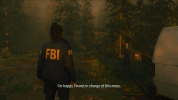davis.anthony
Veteran
Finished building my new PC so fired up Alan Wake 2 and honestly, I'm not that impressed by it graphically and I do think that CP2077 with over drive mode is a vastly better looking game.
Does Alan Wake 2 get better looking as you delve deeper in to?
Does Alan Wake 2 get better looking as you delve deeper in to?



